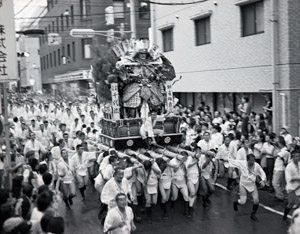Yamakasa
|
The Hakata Gion Yamakasa, which boasts nearly 760 years of tradition, is a religious dedication to shrines housing local deities. There are differing theories as to its origins, but historians generally believe it started in 1241. Locals of what was then called Hakata rode on shelves carried on the shoulders of others, from which they splashed “prayer water” (the same shelves were used for offerings during Obon). This was to ward off epidemics that threatened the town. Fukuoka city was once two different towns; the warrior class lived in Fukuoka and the merchants were squeezed along the Nakagawa river in Hakata. Yamakasa, which was a Hakata festival, never crossed the Nakagawa river. Yamakasa, however, was designated an “important intangible folk cultural asset” by the national government in 1979. Then, by city government decree, Yamakasa entered Fukuoka (what is now Chuo Ward) for a special public procession of the floats. Although Yamakasa lasts from July 1st to the 15th, the 13th is the only day that it enters old Fukuoka. Yamakasa involves two floats, one decorative and the other for actual carrying. In the Meiji era, floats towering over 10m were actually carried through the streets—those are only on display now. Nowadays, more practical floats for carrying are used so that they don’t snap all the electrical wires! The decorative floats are gaudy, with kabuki likenesses, characters from anime and popular legend as well as Hakata dolls attached to them. But together with the floats for carrying, they are completely dismantled after the race at the end of Yamakasa and their role for that year is over. The finale is the race early on the morning of July 15th. Beginning just after 1am, each of the floats visits Kushida Shrine. Onlookers have swelled and many stay up all night to wait for the start. The float bearers in their special loincloths and vests seem to have a kind of natural, naked style. Many may be surprised by this fact, but during Yamakasa, it is a ceremonial dress on equal status with a suit, and can be worn for other public occasions like weddings. At 4:59am, huge Japanese drums sound from a turret. The first float enters Kushida shrine and does a full rotation before stopping. For one minute the Hakata celebratory song is chanted, after which the float bursts from the shrine. A total of seven floats perform this, each chasing after the other. Until the end some 5km later, it is a frenzied affair with voices shouting osshoi, osshoi as the floats race through town. People along the side of the road, meanwhile, splash water that turns into steam in all the heat and excitement. Those who just don’t think they can get up at such an early hour should watch on the 12th, when there is a kind of rehearsal for the real thing at 3:59pm. The course is actually 1km shorter but otherwise doesn’t change much—you’ll still get a feel for Hakata spirit and the raw vigor of Yamakasa. See more photos in the online galleries at: |
760余年の伝統を誇る博多祗園山笠は、博多の総鎮守である神社の奉納神事です。山笠の起源については諸説ありますが、一般には1241年の鎌倉時代にの開祖であるが当時博多に流行した疫病を鎮めるため、町の人々が担ぐ精霊棚 (お盆の時に供物を乗せる棚)に乗って祈祷水を撒いたのが始まりとされています。 また、福岡市は那珂川を挟んで商人の町博多と武士の町福岡に分かれており、博多の祭りである山笠が那珂川を越えて福岡に入る事はありませんでした。しかし1979年に国の重要無形民俗文化財に指定された事により、福岡市の要請で山笠が福岡(現在の中央区)に入って祭りを披露する集団山見せが始まりました。7月1日から7月15日までの祭りの期間中、山笠が福岡に入るのは7月13日の一日だけです。 山笠は飾り山と舁き山があり、明治の中頃までは10メートルを超える飾り山をそのまま担いでいましたが、山笠が電線を切断して回る為、現在は別に高さを抑えた舁き山を作るようになりました。 歌舞伎の名場面、アニメや昔話のキャラクター等の豪華な博多人形を付けた飾り山は舁き山と同様、追い山が終わると同時に解体されその年の役目を終えます。 その祭りのフィナーレを飾る追い山は、7月15日の早朝に行われます。午前1時を過ぎる頃から櫛田神社前に次々と舁き山が据えられ、見物客も増えほぼ徹夜でこの神事が始まるのを待ちます。山笠の舁き手は水法被に締め込み姿というまるで裸同然のスタイル。驚かれる方も多いと思いますが、山笠が終わるまでは背広同等の正装で、結婚式などの公の場での着用も可能です。 午前4時59分、櫓の上で打たれる大太鼓を合図にまず一番山が櫛田入りし、を回ったところで一旦ストップ。約1分間「博多祝い唄」を合唱した後、再び境内を飛び出して行った一番山を二番山から七番山までが追います。廻り止めまでの約5kmをオッショイオッショイの掛け声と共に疾走する姿は圧巻で、沿道から浴びせられる勢い水もたちまち湯気に変わる程の熱気と興奮です。 早朝の追い山を見るにはどうしても起きる自信がないという方は、7月12日の追い山ならしが良いでしょう。本番の追い山のリハーサルですがこちらは午後3時59分に行います。コースが本番より1km短い4kmである事以外は変わりませんので、山笠の迫力と「博多んもん」の心意気を是非、生で感じて下さい。 online photo galleries: |
Cultural Information Center
アクロス福岡文化観光情報ひろばでは、福岡県の文化・観光に関する様々な情報を取り揃えています。お電話でのお問い合わせも可能ですので、お気軽にご利用ください。
At the ACROS Fukuoka Building’s Cultural Information Center, there is a vast array of pamphlets and other literature on Fukuoka culture and site seeing. You can also make inquiries by phone (between 11am and 5pm, the Fukuoka SGG club, a group of volunteer interpreters, can take your calls in English).
ACROS Fukuoka Bldg 2F
1-1-1 Tenjin, Chuo-ku
092-725-9100
10am to 6pm (closed 12/29-1/3)









